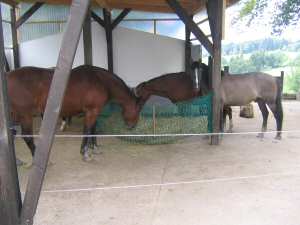Wake up to Welfare!
by Erica Dixon
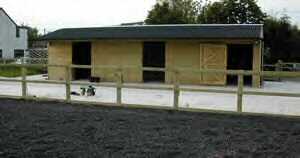 Several eminent people have been talking & writing about equine welfare and natural husbandry for decades. They have often been labelled crack pots or just brushed off as eccentrics. People often say that it's alright for 'them' as they have 60 acres and I don't, but this is not an excuse (keep reading). There is still a huge amount of work to be done in this area, but luckily many people are beginning to see the light. Major welfare societies still stable horses and ponies (not all of them and some welfare officers would rather see horses kept more naturally). Many veterinarians are also ignoring this huge welfare issue. First do no harm.
Several eminent people have been talking & writing about equine welfare and natural husbandry for decades. They have often been labelled crack pots or just brushed off as eccentrics. People often say that it's alright for 'them' as they have 60 acres and I don't, but this is not an excuse (keep reading). There is still a huge amount of work to be done in this area, but luckily many people are beginning to see the light. Major welfare societies still stable horses and ponies (not all of them and some welfare officers would rather see horses kept more naturally). Many veterinarians are also ignoring this huge welfare issue. First do no harm.
We all know about zoos changing their animal husbandry methods, partly due to public pressure and partly due to research. Animals have been removed from small cages and given surroundings designed to respect the nature or their species; allowing them a more natural life within captivity. The public approves of this and many of the public can recognise an extremely distressed animal exhibiting highly abnormal behaviour. Sadly many can't and actually laugh at the animal. You can see this often on those video clip TV shows as well.
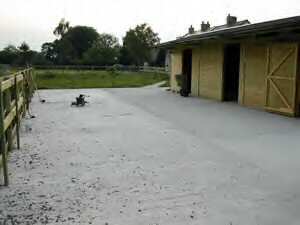 So what would 'Jo Public' think of some of our equestrian competition and racing yards where horses are caged 24/7 bar 'exercise' and exhibiting odd behaviour? Oh, but we don't cage our horses I hear them say, we have nice airy stables. Consider this:
So what would 'Jo Public' think of some of our equestrian competition and racing yards where horses are caged 24/7 bar 'exercise' and exhibiting odd behaviour? Oh, but we don't cage our horses I hear them say, we have nice airy stables. Consider this:
- The average stable size ranges from 10' square to 14' square with the most common size being 12' square i.e. small
- Consider the size of the average 15.2-16.2hh horse living in a 12' x 12' space and how much room the horse needs to turn around or to lie down & get up.
- A stable has walls, low or high, but still walls segregating hard & fast herd animals to solitude with no opportunity for their many social interactions such as grooming, playing, looking out for each other etc etc.
- In fact the size of a stable compared to that of a horse is the same relative size as a pet carrying cage used to transport a dog or cat to, for example, the vet.
- Would you keep your dog or cat in one of these cages for 14-24 hours a day every day? Lying or standing in excrement? No? This is exactly what happens to a horse in a stable no matter how clean it was at 'evening stables'.
- A stable is in effect a nice word for a cage & just to prove a point, some of them even have bars as well as door grills to stop abnormal behaviour!!
It is a crime against nature to put any naturally free roaming animal in a 'stable'.
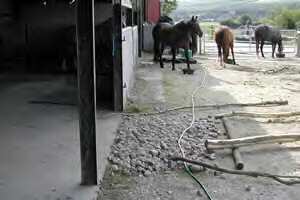 Another point to remember is that no matter how sick or lame a horse is HE OR SHE STILL NEEDS HERD LIFE & OPEN SPACE FOR GENERAL WELFARE & TO FEEL SAFE. I hope that one day vet hospitals will no longer have stables. The same space the stables take up could be dedicated to safe herd life with rubber floors & no ammonia trapping bedding. There should always be an area outside freely available as well. From the experience of Dr Strasser's hoof clinic in Germany, horses taken from home & put into strange surroundings bond quickly as they are all in the same situation. This is because herd life is just so important!
Another point to remember is that no matter how sick or lame a horse is HE OR SHE STILL NEEDS HERD LIFE & OPEN SPACE FOR GENERAL WELFARE & TO FEEL SAFE. I hope that one day vet hospitals will no longer have stables. The same space the stables take up could be dedicated to safe herd life with rubber floors & no ammonia trapping bedding. There should always be an area outside freely available as well. From the experience of Dr Strasser's hoof clinic in Germany, horses taken from home & put into strange surroundings bond quickly as they are all in the same situation. This is because herd life is just so important!
The books of Marthe Killey-Worthington & Stephen Budiansky's 'The Nature of Horses' offer more food for thought on this subject, but bear in mind they were written without knowledge of barefoot living conditions.
Obviously infectious diseases require separation, but if a disease is infectious there will be more than one horse with it. Plus consider that naturally living horses are healthier & less prone to dis-ease.
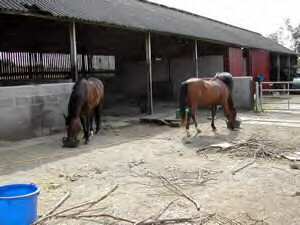 There are many other negative points to consider about keeping equines in stables (even 'just overnight in winter' which equals at least 14 hours). There is one more point that is often overlooked even by behaviour experts. Keeping a horse, pony or donkey in a stable for any length of time is not only mentally damaging but PHYSICALLY DAMAGING as well.
There are many other negative points to consider about keeping equines in stables (even 'just overnight in winter' which equals at least 14 hours). There is one more point that is often overlooked even by behaviour experts. Keeping a horse, pony or donkey in a stable for any length of time is not only mentally damaging but PHYSICALLY DAMAGING as well.
It has been known for centuries (even millennia) that shoes damage horses' hooves. It may be more high profile now, but it still has always been known whether admitted to or not. The double whammy is that restricting an equine from its natural amount of movement also damages not just the hooves, but the entire organism. For example, the equine's heart is too small to work optimally alone & needs the pumping (moving) action of the hooves to pump blood through the lower limbs. In fact, the entire animal is designed to move 18-24 hours per day with only short resting times (not 6 hours all at once) & graze with head low. This is the same for ALL hoofed animals. Did you know that a horse confined to a stable eating hay at head height & looking over the door to see the 'herd' risks underslung (collapsed) heels due to the incorrect weight distribution throughout the body?
HELP I ONLY HAVE 2 ACRES & TWO STABLES!
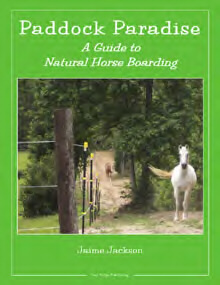
As one example of how to make the living more suitable, I have made suggestions for the average private stable yard with 2-3 acre paddock housing 2-3 equines:
Remove all ammonia-trapping (yuk & it breaks down protein i.e. hoof horn) bedding from stables.
Bolt open the stable doors. If possible, consider removing the entire front wall of the stables save for supporting pillars.
If there is no concrete yard, consider putting one down or extending an existing one for hard standing in the wet winter months.
Flattened hardcore/pea gravel is great for healthy hooves. Broken paving slabs are often available cheaply. Railway sleepers & wooden 'decking' also work. Tarmac companies will often do you a deal if surfacing a road nearby. Remember this is barefoot equine management & healthy bare hooves have grip! If you need rubber mats ask at quarries for old rubber belting (usually free or very cheap).
Open the field gates for 24/7 access to the yard.
Cover up, turn off or remove all water supplies in the field & use water supply in the yard. This encourages movement in & out of the yard & onto the hard standing.
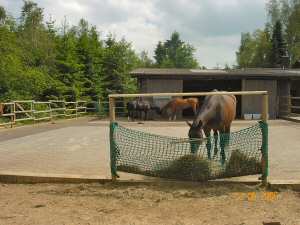 Divide your field in two lengthwise so you have long thin areas leading to your yard as opposed to square areas. Long thin areas encourage more movement & allow letting off steam without crashing into a fence.
Divide your field in two lengthwise so you have long thin areas leading to your yard as opposed to square areas. Long thin areas encourage more movement & allow letting off steam without crashing into a fence.
If your field poaches in winter, or grass is too fattening in summer, you can shut your horses into their yard, overnight or for part of the day, but give them reason to move. Make a 'track' in your yard, put hay out in lots of small amounts preferably in ground feeders. Scatter veg/fruit, oats etc. Design a maze. Put in random scary objects such as big beach balls. Be thankful for the bossy horse. Use your imagination. (Clean up every day)
Rig up temporary or space allowing permanent, feeding chutes. If the weather is very dry chute around hoof soaking pool(s), so you can feed & soak at the same time. Hooves simply need water to prevent drying out and cracking.
Other options are empty farm yards, with attached barns or firmly asking your livery yard owner for a suitable space, such as a partially fenced off yard. Offer to split costs of fencing, use temporary fencing or pay for it & remove it when you can get your own place. If your livery yard owner or farm owner is unhelpful, search until you find one that is willing to help you. Only by voting with your feet & your money will yard owners sit up, take notice & start to change their livery arrangements. Get together with like minded people. If you can afford it, buy & build your own!
Erica Dixon
September 2005
Updated January 2007
Links to more information and others' experiences of 'Paddock Paradise'
Here is a company in UK I would highly recommend with lots of help and advice on electric fencing & competitive prices: UK Country Store (not to be confused with an online company of similar name, but not based in Scotland & who I would definitely not recommend!)
Zareba Fencing - useful ready reckoner to estimate perimeter of acreage
Paddock Paradise in UK
Natural Livery with track system mid Wales
Successful Natural Horsecare - keeping horses barefoot
Paddock Paradise on Right2remainshoeless website "A track system is a realistic alternative for winter turnout in situations where horses are otherwise kept in 24/7 to restrict ‘poaching’ summer grazing."
Paddock Paradise outside UK
Paddock Paradise - Jaime's official Paddock Paradise website
Natural Boarding by Joe Camp (with link to amazing must-watch video!)
Read Joe's amazing book The Soul of a Horse: Life Lessons from the Herd
Horses for Life April 2008 - Paddock Paradise article
